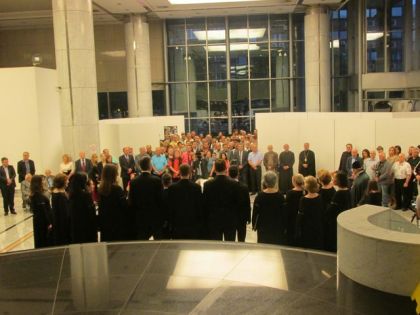Exhibition Prebilovci opened
An exhibition about the crimes committed by the Ustashe in 1941 titled “Prebilovci” opened this evening in Belgrade. The Ustashe killed 850 Serbs out of a total of 1,000 residents of this Serbian village in the Herzegovina, and this village, according to a research done by the Japanese Asahi Shimbun paper, is the place which suffered the most in WWII in Europe.
The exhibition was blessed by His Eminence the Bishop of the Zahumlje-Herzegovina and the Littoral, Grigorije, who said that the exhibition is important since it is in Belgrade “where there are many people who still do not know that there is Prebilovci with such a wound, but also with such a force of life in it.”
“The faith of people of Prebilovci in life is incredible – in 1945 they continued to live there and now, after this last war, they continued to live there. A church, which literary resurrected from bones, is maybe something the most beautiful that happened in our Eparchy in the past several hundreds of years,” Bishop Grigorije said.
The president of the Prebilovci National Society, Milenko Jahura, said that Prebilovci, according to a research done by the Japanese Asahi Shimbun paper, is the village which suffered the most in Europe in WWII.
He said that according to a state commission, 850 people were killed in Prebilovci out of a total of 1,000 residents of this village.
“Women and children were killed on August 6, 1941, in the Surmanicka Pit, which is 66 metres deep. This pit is in the Medjugorje Catholic District, and the killers were residents of Medjugorje, Bijakovici and Surmanci – Croats and Muslims from the neighbouring villages. They were thrown alive into the pit, where they were dying for days. No one was saved,” Jahura said.
He said that a great number of Serbs from Sarajevo was killed in the same pit. They were brought by trains to Surmanci. All the villages in the lower Herzegovina suffered.
172 Serbs survived the massacre, of whom 156 were grown up men and women and 16 children.
“In every nation, Prebilovci would have a special value, if not as the Serbian village which suffered the most, then as a European village which suffered the most. Unfortunately, the awareness of sufferings in the Independent State of Croatia is blurred among the Serbs so that this was forgotten and Prebilovci is not a value it should be,” Jahura said.
He said that pressure is being put on Prebilovci in order to forget the crime, so that the village cannot get a road sign even though thousands of people are travelling on the road from Sarajevo to the coast and they do not know that they are passing through Prebilovci.
The president of the Jadovno 1941 Association, Dusan Bastasic, expressed the conviction that the exhibition will contribute to revealing the tragedy of Prebilovci and the people of the eastern Herzegovina.
The exhibition, authored by students of the Banjaluka University, Predrag Lozo and Dragoslav Ilic, contains photographs, life stories, texts and documents about the crime and Prebilovci residents, and it is a joint project of the Novi Sad Cultural Centre and the Jadovno 1941 Association of Banjaluka.
The construction of the church in Prebilovci, in whose crypt several thousand Serbs killed in the Neretva River valley in WWII were buried, started in 1991.
However, in 1992, the Croatian Army commanded by Gen. Janko Bobetko, mined the crypt and destroyed it with bulldozers, doing everything to destroy the traces of the crime.
Even though a great number of mortal remains was destroyed, seven cases are preserved. The Holy Assembly of the Serbian Orthodox Church canonized the Prebilovci martyrs and as of last year they have been commemorated on August 6.
The church in Prebilovci is being reconstructed again thanks to numerous donors, including a great number of Herzegovina Serbs. The Republika Srpska Government provided great aid and support to the construction of the church.
The reconstructed church in Prebilovci should be sanctified on August 8.
The president of the Coalition of Refugee Associations in Serbia, Miodrag Linta, the retired Bishop of the Zahumlje-Herzegovina and the Littoral, Atanasije, SRNA’s retired journalist and speleologist Miroslav Kurtovic, who took part in the removal of bones of those killed in Prebilovci, and numerous guests attended this evening’s opening of the exhibition.
The exhibition is in the building of the National Bank of Serbia in Belgrade and will be opened till May 28.
Vezane vijesti:
KAKO JE PREBILOVAČKA NEJAČ GURANA U ŠURMANAČKU JAMU, U KOJOJ JE SKONČALO 2000 SRBA
Gostovanje predsjednika UG Jadovno 1941. na TV NAŠA i BN TV
IZLOŽBA „PREBILOVCI“ U BEOGRADU
Vladika Grigorije: Prebilovci su najjači i najsvježiji simbol Vaskrsenja!


